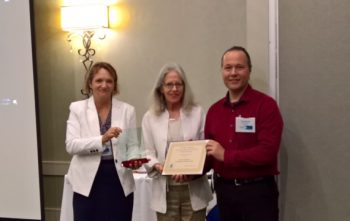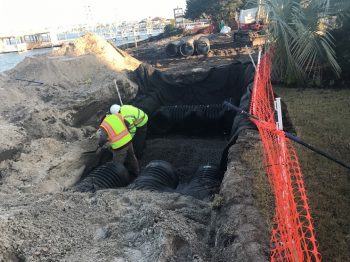CHARLESTON, S.C. — The North Carolina Coastal Federation, on behalf of a collaborative team, including the North Carolina National Estuarine Research Reserve (NCNERR), is the recipient of a regional 2017 Rain Catcher Award from the Environmental Protection Agency (EPA) Region 4 for various innovative stormwater runoff infiltration projects in Wrightsville Beach.

Tracy Skrabal accepts the award on May 15, 2017 in Charleston, S.C.
The federation is accepting the award today at the 2017 Municipal Wet Weather Stormwater Conference in Charleston, S.C. EPA Region 4 holds this annual competition “for excellence in implementation of stormwater green infrastructure projects,” according to the EPA. EPA Region 4 is made up of eight Southeastern states.
The awards are given in four categories: Municipal, Commercial, Tribal and Neighborhood/Community. The team was selected as the winner in the Community category.
“We are very proud to receive EPA’s Rain Catcher Award on behalf of our partners who worked hard to make these projects successful,” said Tracy Skrabal, coastal scientist for the federation’s Wrightsville Beach office. “The lasting benefit of this recognition is that it helps us to educate other municipalities, as well as public and private landowners, about these innovative and highly effective project designs.”
To accomplish the projects, the federation and NCNERR teamed up with many partners: the Town of Wrightsville Beach, the City of Wilmington, the N.C. Department of Transportation, the N.C. Division of Energy, Mineral and Land Resources, the N.C. Division of Coastal Management, the N.C. Division of Marine Fisheries’ Shellfish Sanitation & Recreational Water Quality program, Cooperative Extension Service, the N.C. Division of Soil and Water Conservation, University of North Carolina Wilmington, Blockade Runner Beach Resort and professional consultants.
The team received this award for eight projects under the Bradley and Hewletts Creek Watershed Restoration Plan. These projects redirect runoff from hard surfaces and allow runoff to filter into the ground, providing successful demonstrations of options to prevent polluted stormwater runoff for new and redevelopment scenarios.
The projects were implemented on both public and private properties and are highly visible. The projects include cost-effective, straightforward and innovative designs that work within existing urban landscapes. These include: regrading an area in front of a restaurant in order to infiltrate runoff that formerly flowed into a drain; two curb cuts that redirect 8,600 square feet of runoff into a grassy median; installation of reverse storm inlets that divert runoff into existing grassy areas to infiltrate runoff; disconnecting a street drain system into a rain garden; check dams; pervious pavement; and soundside street-end projects that redirect flow from swimming waters, including construction of an innovative perforated infiltration system/cistern design that redirects runoff from recreational waters at the Blockade Runner Beach Resort.

Construction of infiltration trench system with a 42-foot perforated pipe at Blockade Runner Beach Resort.
Whitney Jenkins, coastal training program coordinator for NCNERR, served as the project’s collaborative lead.
“Stormwater management and water quality protection have always been a focal area for training and stakeholder engagement for the NCNERR,” Jenkins said. “This project is a great example of how small scale retrofits can make a big difference in controlling stormwater and protecting coastal water quality.”
Some of these projects are showcased on the federation’s Walk the Loop tourthat allows pedestrians to take a walking tour of retrofits along the John Nesbitt Loop in Wrightsville Beach. The Blockade Runner projects were recently completed and are successfully redirecting runoff.
Access the full award application here to learn more about the projects. For questions or more information, please contact Tracy Skrabal at 910-509-2838.
